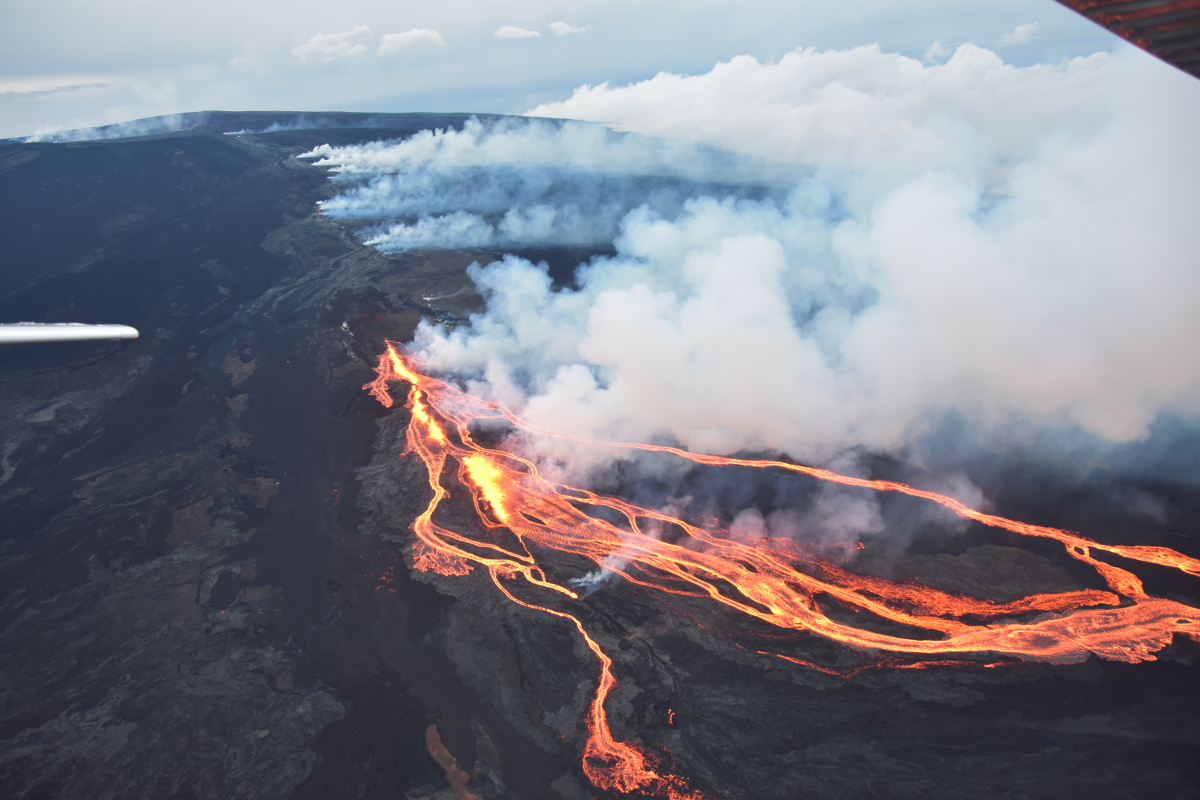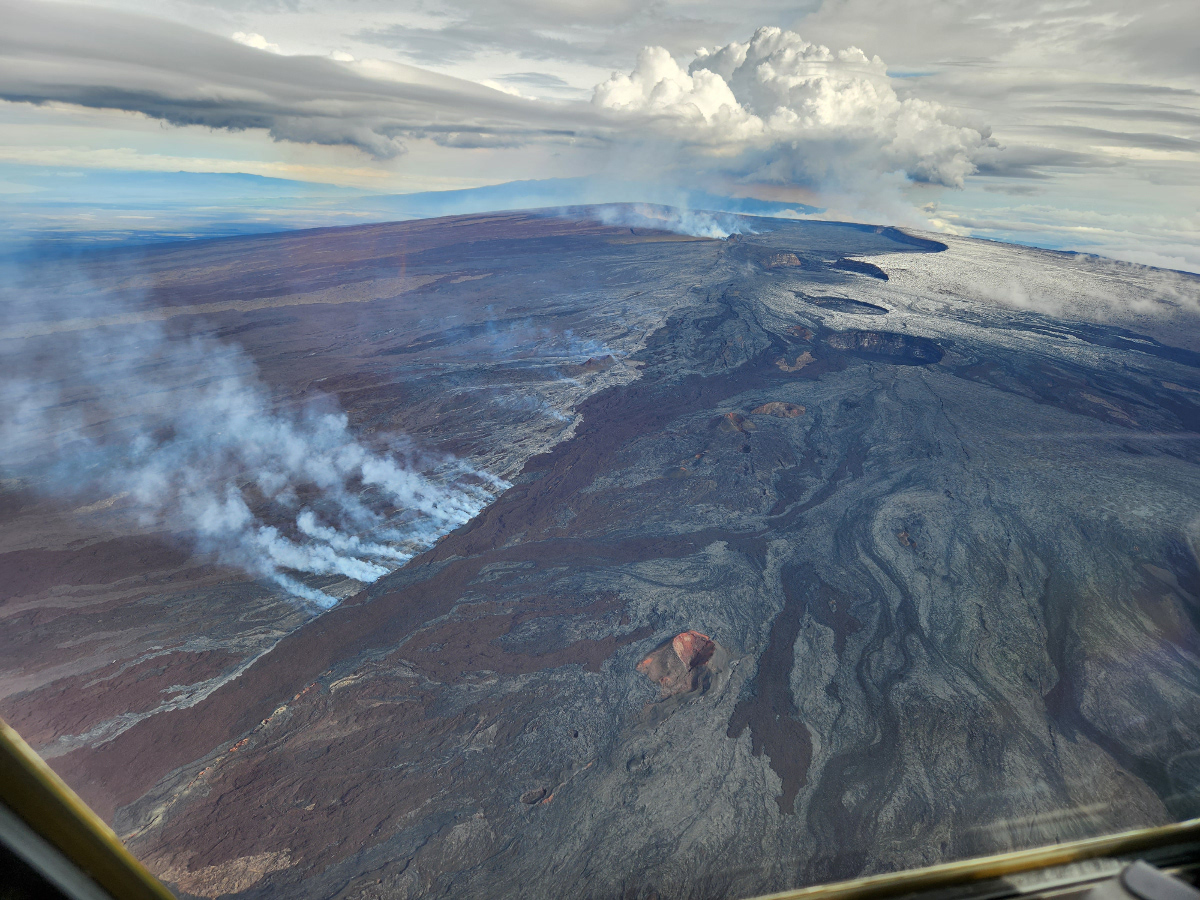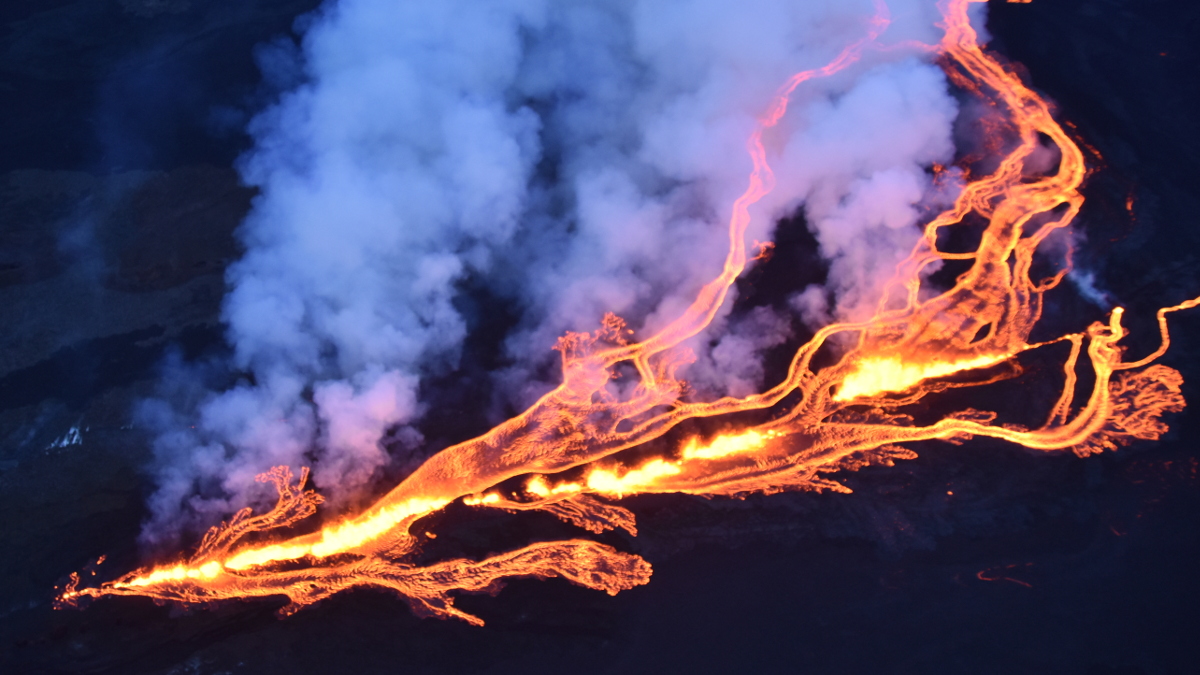
USGS: “Aerial photo captured during an overflight of the Northeast Rift Zone eruption of Mauna Loa at approximately 5-6:30 p.m. HST on November 28, 2022. This photo is looking at the line of fissure vents erupting above 10,000 ft elevation on the Northeast Rift Zone of Mauna Loa. Lava flows being generated from the line of fissure vents are on the northeast flank of Mauna Loa.” (Image courtesy of Civil Air Patrol)
(BIVN) – From this week’s Volcano Watch article written by U.S. Geological Survey Hawaiian Volcano Observatory scientists and affiliates:
The first few hours of Mauna Loa’s eruption were dynamic, and volcanologists intently watched monitoring data to track changing conditions and understand how the eruption was developing. This monitoring is crucial to issuing hazards notifications to communities that may be at risk and is why we continue to closely monitor this new eruption.
For months, monitoring data had indicated that Mauna Loa was inching closer to an eruption. The volcano had been inflating for years, and the past few months had seen an uptick in the rate of earthquakes. In late September 2022, HVO issued an Information Statement summarizing the increased activity, and by early October, daily, instead of weekly, activity updates were initiated. HVO also began holding community meetings in areas of the island that might be impacted by a Mauna Loa eruption, including Hawaiian Ocean View Estates, South Kona, and Pāhala.
The eruption started in Mokuʻāweoweo, Mauna Loa’s summit caldera, at about 11:30 p.m. HST. The handful of scientists that responded to alarms about 45 minutes before the eruption quickly turned into an online meeting of 15–20 experts in seismology, deformation, geology, and satellite imagery. Additionally, Hawaiʻi County Civil Defense Agency (HCCDA) was immediately appraised of the volcano’s behavior, both via the online meeting and with the addition of a volcanologist who quickly went to the HCCDA Emergency Operations Center in Hilo. Scientists from USGS volcano observatories in Alaska, California, and Washington also joined to assist.
The primary concern was that the eruption might shift toward the Southwest Rift Zone (SWRZ). Lava from Southwest Rift Zone eruptions can reach populated areas within hours, so recognizing the early signs of a rift zone eruption is key.

USGS: “Aerial view of Mauna Loa summit with Lua Hou in the foreground followed by Lua Hohonu, South Pit, and Mokuʻāweoweo summit caldera. A small dusting of snow covers the ground east of the summit. The steaming fissure was active during the beginning of the eruption, but this morning the lava in the summit caldera had already cooled to a black color. The white plume in the background is rising from the fissures in the Northeast Rift Zone.” (USGS photo J. Schmith)
A few hours after the eruption started, images began to appear on social media of lava flows visible from Kona. In the dark, these flows looked menacing, and the public had clear concerns that the eruption had made its way into the Southwest Rift Zone. Indeed, the fissure that first opened in Moku’aweoweo continued opening towards the south, outside the topographic caldera, but still inside Mauna Loa’s summit region. This produced the lava flow on the southwest side of the summit that was visible from the Kona coast. These flows did not threaten any populated areas and were ultimately short-lived.
Monitoring data—ground tilt, seismic, cameras, thermal satellite, and infrasound (low-frequency sound)—continued to show that the eruption was focused at the summit. Volcanologists remained glued to their computer screens…
By about 6 a.m. HST on November 28, reports from observers on the ground, as well as thermal satellite data, indicated that the eruption had moved into the Northeast Rift Zone. A few minutes later, this was confirmed by infrasound (low-frequency sound waves) and seismicity, and cameras showed that the summit-area eruption had stopped. With first light, volcanologists were in the air, on overflights and being shuttled to the eruption site to gather additional data and observations. But they began to breathe a bit easier. History suggests that once a Mauna Loa eruption moves into one rift zone, it stays there.
Those tense first several hours served as a good test of how HVO is able to work with HCCDA officials and volcanologists from other USGS offices to rapidly respond to volcanic activity. Together, these agencies continue to monitor the Northeast Rift Zone eruption of Mauna Loa and keep the public informed on the activity.
As of December 8, the main lava flow front that was approaching the Daniel K. Inouye Highway (Saddle Road) stalled about 1.7 mi (2.8 km) away. Lava continues to erupt from fissure 3 but these flows are now closer to the vent and are working their way downslope again.
Future Mauna Loa eruptions, from the summit, either rift zone, or radial vents, are inevitable, but it is impossible to forecast precisely when those might happen. HVO’s monitoring networks plus the high level of community awareness provide the best mitigation for hazards from any such eruption.
HVO is grateful to the Island of Hawaiʻi for your support, awareness, and engagement during this latest eruption crisis. Mahalo nui loa and mālama pono.


by Big Island Video News7:05 am
on at
STORY SUMMARY
HAWAIʻI - This week's Volcano Watch focuses on the initial hours - and the uncertainty - of the November 28 eruption of Mauna Loa.